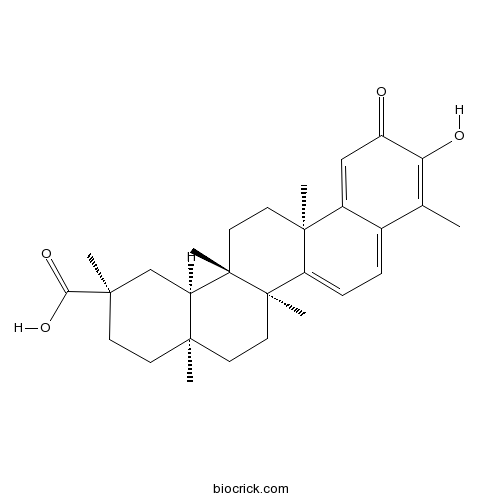Celastrus aculeatus
Celastrus aculeatus
1. The products in our compound library are selected from thousands of unique natural products; 2. It has the characteristics of diverse structure, diverse sources and wide coverage of activities; 3. Provide information on the activity of products from major journals, patents and research reports around the world, providing theoretical direction and research basis for further research and screening; 4. Free combination according to the type, source, target and disease of natural product; 5. The compound powder is placed in a covered tube and then discharged into a 10 x 10 cryostat; 6. Transport in ice pack or dry ice pack. Please store it at -20 °C as soon as possible after receiving the product, and use it as soon as possible after opening.
Natural products/compounds from Celastrus aculeatus
- Cat.No. Product Name CAS Number COA
-
BCN5986
Celastrol34157-83-0
Instructions

Ethyl Acetate Extract from Celastrus aculeatus Merr. Suppresses Synovial Inflammation in Adjuvant Arthritis Rats through Apoptosis Induction of CD4(+)CD25(+)FOXP3(+) T Cells.[Pubmed: 25548591]
Celastrus aculeatus Merr. has been widely used in traditional Chinese medicine to treat rheumatoid arthritis (RA) in clinic. However, the main active fraction of this plant is still unclear. In this study, we attempted to evaluate the suppressive effect of ethyl acetate extract (EAE) from Celastrus aculeatus Merr. on synovial inflammation in adjuvant arthritis (AA) rats induced by Mycobacterium tuberculosis H37Ra (Mtb) and to explore the underlying mechanisms. SD rats immunized with heat-killed Mtb were fed with EAE and observed for erythema, swelling, and induration of each paw. The pathologic changes in joint synovium were tested by hematoxylin-eosin staining. Apoptosis induction of synoviocytes was tested immunohistochemically. Apoptosis of peripheral lymphocytes and the level of regulatory T cells were analyzed by flow cytometry. After treatment with EAE, the joint inflammation in rats with AA was alleviated. Both apoptotic ratios of synoviocytes and peripheral lymphocytes and the ratio of CD4(+)CD25(+)FOXP3(+) to CD4 regulatory T cells were significantly increased. In summary, we first demonstrated that EAE of Celastrus aculeatus Merr. can inhibit synovial inflammation in AA rats through apoptosis induction of CD4(+)CD25(+)FOXP3(+) T cells. Our study provides a rationale for the application of Celastrus aculeatus Merr. to treat RA.
[Comparative study on macroscopic and microscopic identification of Celastrus aculeatus and Kadsura heteroclite].[Pubmed: 23213733]
To compare and identify Celastrus aculeatus and Kadsura heteroclita with pharmacognosy methods for analyzing the quality of the crude drug.
Celastrus treatment modulates antigen-induced gene expression in lymphoid cells of arthritic rats.[Pubmed: 22697077]
Rheumatoid arthritis (RA) is a debilitating autoimmune disease of global prevalence and the disease process primarily targets the synovial joints. Despite improvements in the treatment of RA over the past decade, there still is a need for new therapeutic agents that are efficacious, less expensive, and free of severe adverse reactions. Celastrus has been used in China for centuries for the treatment of rheumatic diseases. Furthermore, we previously reported that ethanol extract of Celastrus aculeatus Merr. (Celastrus) attenuates adjuvant-induced arthritis (AA) in rats. However, the mechanisms underlying the anti-arthritic activity of Celastrus have not yet been fully defined. We reasoned that microarray analysis might offer useful insights into the pathways and molecules targeted by Celastrus. We compared the gene expression profiles of the draining lymph node cells (LNC) of Celastrus-treated (Tc) versus water-treated (Tw) rats, and each group with untreated arthritic rats (T(0)). LNC were restimulated with mycobacterial heat shock protein-65 (Bhsp65). We identified 104 differentially expressed genes (DEG) (8 upregulated, 96 downregulated) when comparing Tc with T(0) rats, in contrast to 28 (12 upregulated, 16 downregulated) when comparing Tw and T(0) rats. Further, 20 genes (6 upregulated, 14 downregulated) were shared by both Tw and Tc groups. Thus, Celastrus treatment (Tc) significantly downregulated a large proportion of genes compared to controls (Tw). The DEG were mainly associated with the processes of immune response, cell proliferation and apoptosis, and cell signaling. These results provide novel insights into the mechanism of Celastrus anti-arthritic activity, and unravel potential therapeutic targets for arthritis.
[Study on the activated fraction with proliferation and apoptosis effect on T lymphocyte of Celastrus aculeatus].[Pubmed: 22233039]
To screen the activated fraction from Celastrus aculeatus and study its effect on T lymphocyte apoptosis.
Celastrus aculeatus Merr. suppresses the induction and progression of autoimmune arthritis by modulating immune response to heat-shock protein 65.[Pubmed: 17645785]
Complementary and alternative medicine products are increasingly being used for the treatment of autoimmune diseases. However, the mechanisms of action of these agents are not fully defined. Using the rat adjuvant arthritis (AA) model of human rheumatoid arthritis, we determined whether the ethanol extract of Celastrus aculeatus Merr. (Celastrus), a Chinese herb, can down-modulate the severity of AA, and also examined the Celastrus-induced changes in immune responses to the disease-related antigen mycobacterial heat-shock protein 65 (Bhsp65). AA was induced in the Lewis (LEW; RT.1l) rat by immunization subcutaneously with heat-killed M. tuberculosis H37Ra (Mtb). Celastrus was fed to LEW rats by gavage daily, beginning either before Mtb challenge (preventive regimen) or after the onset of AA (therapeutic regimen). An additional group of rats was given methotrexate for comparison. All rats were graded regularly for the signs of arthritis. In parallel, the draining lymph node cells of Celastrus-treated rats were tested for proliferative and cytokine responses, whereas their sera were tested for the inflammatory mediator nitric oxide. Celastrus feeding suppressed both the induction as well as the progression of AA, and the latter effect was comparable to that of methotrexate. Celastrus treatment induced relative deviation of the cytokine response to anti-inflammatory type and enhanced the production of anti-Bhsp65 antibodies, which are known to be protective against AA. Celastrus feeding also reduced the levels of nitric oxide. On the basis of our results, we suggest further systematic exploration of Celastrus as an adjunct therapeutic modality for rheumatoid arthritis.


